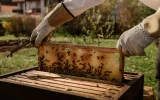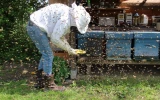How Long Can a Bee Live Without Its Stinger?
If bees lose their stinger after attacking us, how long do they have left to live? Here's a quick look behind the science of bees, stingers, and their venom.
Honeybees only have several hours left to live after losing its stinger before succumbing to internal organ failure and fluid loss. This is because human skin is thick and their stingers have jagged double edges they can't pull out unless they rip themselves apart.
It's a graphic death and definitely not one you'd wish on any living creature. Honeybees only sting when they feel like their hive is being threatened. Aside from treating your bees with respect, I'll walk you through how you can treat and recover from a sting wound so that you can go back to caring for your apiary.
Summary
- Honeybees will only live a few more hours after they are separated from their stinger.
- Treat a sting by removing the stinger, washing the area, applying hydrocortisone, and monitoring further symptoms.
- While getting stung is a risk all beekeepers have to take, ethical beekeeping and best industry practices will help ensure you and your bees' safety. Always wear laundered beekeeping gear, move carefully, and treat them with respect.

On this page:
Why Do Honeybees Die After They Sting?
The description ahead may get a little graphic.
Humans have thick skin and once a honeybee sticks their stinger in, they cannot fly away unless they self-amputate. This is because their stinger is shaped like a double-edged sword with multiple prongs. As a result, it lodges deep into the skin of its victim and stays there. The honeybees' repeated attempts to break free will eventually rupture their lower abdomen, so as they fly away, their retreat pulls out all sorts of internal parts: muscle, digestive material, glands, and a venom sac.
Honeybees do not usually die after stinging other insects or spiders because their stingers, for the most part, can pierce an insect's thin exoskeleton and unsheathe without any damage. They only die after stinging humans or other mammals.
What Happens to You After You Get Stung?
Even though the honeybee has left, their detached stinger is not done with you. The barbed shafts will move back and forth, digging into your skin and causing pain. Muscular valves will pump melittin, which is a toxin, from the venom sac and inject it into the wound. This will continue for several minutes after the initial sting, which is why it's important to deal with the stinger immediately.
After a honeybee stings you, it releases alarm pheromones as well. This alerts its fellow nestmates to the perceived threat. As a result, they will stick out their stingers and attack anything that moves close to them. This is why it is best to retreat after getting stung, and to have your beekeeping gear laundered regularly so that any alarm pheromones remaining on your equipment are washed away.

How to Treat a Sting
As a beekeeper, you will always have to be wary of getting stung. Even if you are not allergic to bees, having an EpiPen on hand could help save your life or the life of someone else in case of an unexpectedly strong allergic reaction. In addition, acting quickly will be the key to alleviating pain, discomfort, and further distress.
The amount of pain you feel after getting stung also depends on where in your body the wound is located. According to this study on honey bee sting pain index by body location, the most painful places nostril and upper lip. The least painful locations are the tip of the middle toe, skull, and upper arm.
It is worth noting that this study was only conducted on the author, who is a male. Research into painfulness based on body location for bee stings is still in development.
Bee stings might pose a greater harm if they've happen near the throat, eyes, nose, or inside the ear, especially in children. Most people will experience an allergic reaction manifesting in redness, pain, swelling, and itching. This will usually subside in one or two days, but others may have symptoms that last throughout the week. A small subset of people, and the reason you are advised to have an Epi-pen just in case, will have a severe and life-threatening reaction to getting stung.
If you or someone close to you has been stung by a bee, leave the area and treat the wound in a safe place. Watch for signs of anaphylaxis, witch include difficulty breathing, hives, nausea, a rapid heart rate, and swelling of the throat, lips, or tongue. You can administer an EpiPen to manage the symptoms, but you will still need to seek medical attention to further evaluate your condition.
Here are three quick steps to take after a bee stings you or someone you know. Keep in mind that other animals, like our pet dogs and cats, are also vulnerable to bee stings. Regardless of who got stung, make sure to treat the situation quickly and carefully.
Remove the stinger
Locate the stinger and scrape it off with a card or another straight-edge object. If you try using your fingers or tweezers to pull it out, this could pinch the stinger and encourage it to inject more venom.
Clean the wound
Gently wash the area with soap and water, dry it off, and apply a little hydrocortisone. This will help reduce the reaction. If you don't have any hydrocortisone cream on hand, you could try mixing baking soda and water instead. Use cold compresses and ice packs and if you've been stung on the arm or leg, elevate it.
Remove any accessories you have near the sting because it may become difficult to take off once the site becomes swollen.
Ease the symptoms and stay vigilant
Take over-the-counter pain relievers as needed for the pain. Antihistamine pills can also relieve itchiness, and calamine lotion can help soothe the affected area. If your symptoms do not improve after several days, or if the site becomes red and warm, consult a medical professional. This may be an indication that the wound has become infected.
Why Do Bees Sting?
There are many kinds of bees, and sometimes honeybees may even be mistaken for wasps or hornets because of their appearance. However, they are incredibly timid creatures and will only ever attack when they think the hive is in danger. The honeybee's bad reputation is all due to wasps, which are much more combative.
From an evolutionary and biological standpoint, bees sting in defense of the hive because the hive's survival is their only way of making sure that their genes are passed on. Female worker bees, which are the only honeybees with a stinger, cannot reproduce. Only the queen bee and the male drones can do so, which is why the workers can get adamant about guarding their home. With that in mind, it makes sense for worker bees to be willing to lay down their lives when their hive has been threatened.
Do Honeybees Know They'll Die After Stinging Us?
A bee's sting is the ultimate act of martyrdom, but do they know what's coming for them after? Most bee experts believe that they don't. The only reason that they die after stinging human beings is because they're responding to a perceived threat and in their haste, they do not assess how our thick skin could rip out their stinger. Ultimately, their stingers are meant to be used as a defense mechanism against other insects, not humans.
Overall, honeybees will only ever sting in self defense. It's a common misconception that they have a personal vendetta out for all humans. These insects play a vital role to our ecosystem and as beekeepers, we need to learn how to work alongside them sustainably and ethically.
Why Can Only Female Worker Bees Sting?
The stinger, which is also known as an ovipositor, is actually a modified egg-laying organ in honeybees. It is part of the female bee's reproductive system. Queen bees can use their ovipositor to lay eggs and sting. However, female worker bees are sterile and cannot lay eggs, so their ovipositor exists for the sole purpose of attacking and guarding the hive.
Male drones exist solely to reproduce with the queen. They do not have a stinger because they do not have any eggs to lay.
Can Honeybees Sting Other Honeybees?
Yes. While it is unlikely, honeybees can sometimes accidentally sting their nestmates when they mistake them for intruders.



